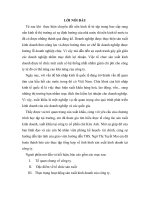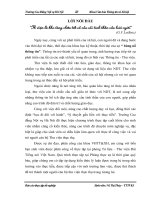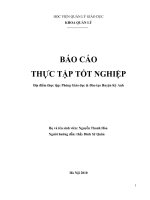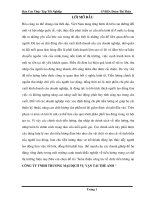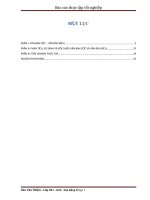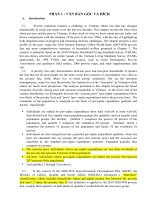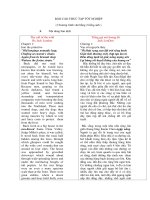Báo cáo thực tập tốt nghiệp tiếng anh (3)
Bạn đang xem bản rút gọn của tài liệu. Xem và tải ngay bản đầy đủ của tài liệu tại đây (255.09 KB, 47 trang )
Part I:
1.1
Introduction
Rationale of the study
English is the language of international communication.
In recent years there are more and more people considering
about the need of English learning. In order to improve the
quality of English learning and teaching many great efforts
have been made. These include the search for and implication
of new and more effective teaching methods. Special
attention has also been paid to research in different areas of
the teaching and learning English. In the processes of
learning, however, learners cannot avoid errors. As Spada and
Lightbown (2002, p.167) stated that: “Errors are natural part
of language learning. The errors reveal the patterns of
learners’ developing interlanguage systems – showing where
they have over generalized a second language rule or where
they have inappropriately transferred the first language rule
into the second language ’’ .
For second language learners in general and for second
language students at secondary school in particular, or even
others who have acquired a high level of English proficiency
still make errors in their production of the second language.
We can see clearly the evidences of these errors in different
parts. For example: In syntax, Vietnamese learners made
errors
in
following
areas:
wrong
use
or
omission
of
prepositions and articles as in the following example sentence
(In the left bank of Huong river *), wrong use of word order in
the sentence (She very much needs to meet them *).
1
Alternatively, wrong form of verbs in tenses is also a difficulty
as (He goes to school yesterday *).
In learning English grammar, especially the learning
tenses, there are many difficulties and errors for Vietnamese
learners of English as well as students at secondary schools.
Although they have been taught and understood the rules of
grammar clearly, they often make errors and some kinds of
errors even become habitual. These errors can be seen in
both learning process at school and the results of the exams
at the end of each term. Therefore, it is necessary to carry out
an investigation into the use of tenses, especially into the use
of the present perfect tense to study errors, which made by
students to identify their causes and find out the solutions to
help improving the effects of teaching and learning English.
For the reasons as above, the writer has decided to
choose the topic “An investigation into errors of the use of the
present perfect tense by second language learners at
secondary school’’.
1.2
Aims of the study
The study reported in this thesis aims to:
- Identify errors in using the present perfect tense
faced by Vietnamese learners at high school
- Find the major causes and sources of the errors
committed by high school students in using the present
perfect tense, and
- Make some suggestions for teaching and learning
this tense.
2
1.3 Scope of the study
English grammar is a complex field for both learners and
researchers. Due to limit time and research condition, this
study does not aim at covering all problems or difficulties met
by students in learning English grammar. This thesis will focus
on investigating students’ errors in the acquisition of English
particular
grammatical case: The uses of one
English
syntactic structure named the present perfect tense, which is
often used incorrectly by Vietnamese students.
1.4 Methods of the study
To meet the aims of the study, we apply the following
methods:
- Investigating and analyzing method
- Explanation method
- Comparison method
- Synthesis method
1.5 Design of the study
There are three parts in this research paper
Part I: Introduction
This part deals with the rationale, aims, scope, methods, and
design of the study.
Part II: Content
This part consists of three chapters:
Chapter I: Theoretical background
This chapter will provide an in-depth review of the
relevant literature related to the issue under investigation.
Especially, a review of the uses of the present perfect tense in
English will provide the theoretical framework for the
3
identification of the errors that students made. In addition,
theories about the sources of errors will help explore what
factors caused students’ commitment of errors in using the
present perfect tense. Error analysis as the main theoretical
tool for analyzing data will also be reviewed.
Chapter II: The study
This chapter will present the methodology adopted to
collect data for the research, which includes the description of
research
questions,
setting,
instrumentations,
and
data
collection techniques. This chapter will also present and
discuss the results and findings of the study.
Chapter III: Findings and discussion
This part will summarize major findings, suggest some
implications for teaching and learning the present perfect
tense in English.
Suggestions for further researches will also be
presented.
Part III: Conclusion
This part will summarize what have been presented in
the thesis.
The appendixes and references are placed at the end of the
study.
Part ii: content
Chapter I: Theoretical background
4
1.1
Tense and aspect in English
There are various traditional school grammarians as
well as linguists paying attentions to English tense and
English aspect category. They considered the category as a
complex study. According to Geoffrey Leech who identified
verb tense and verb aspect as “two of the most troublesome
areas of English’’ (Jacobs, 1985, p.187). With the aims at
helping learners to understanding further this field, the thesis
would like to introduce some general points of view about
this.
1.1.1
Tense in English
According to Quirk et, al (p.40) “Time is a universal,
non-linguistic concept with three divisions: past, present,
future’’
The diagram of time
Past
present
future
Diagram 1.1.1. The diagram of time
In English Syntax, Jacobs (p.187) believes that
“Aristotle who is said to have been the first to recognize the
category of tense’’. He also observed, “there were systematic
variations in the form of Greek verbs, variations that could be
correlated with time notions such as past and present’’ .This
lead to some different definitions of other linguists. Quirk et,
al, (2003, p. 40) defined tense as “the correspondence
between the form of the verb and our concept of time’’.
Jacobs, (1995, p.187) defined that “tense is the grammatical
marking on verbs that usually indicates time at which some
5
other situation was in force’’. It refers to absolute location of
an event or action in time of either speaking point or others. It
is remarked by inflections such as “s /es’’, “d / ed’’ or other
past participle verbs.
For example:
It snows in Alaska
(1)
present tense
It snowed in Alaska, yesterday
(2)
past tense
(Azar, 2004, p. 3)
The first sentence is the present tense when the action
(event) which is happened in time of speaking and marked by
an inflection “s”. However, the first sentence’s tense would be
the past tense if the narrative sentence’s action (event)
happened the past and now it is retold. The verb will be
marked by an inflection “d / ed ’’. The second sentence is in
the past tense because time reference is in the past
“yesterday” and verb is marked by an inflection “ed”.
The tense system involves distinctions of time reference,
and is grammaticalized to give only two tenses: past and
present. Studying English tense, Jacobs also mentioned that
there is “a two-tense system” in English, which is past tense
and present tense.
Present tense: Time reference of action can be in the past
time,
in
time
of speaking, even
in
future
time.
The
grammatical markings are inflection “s”, “es”
For example:
Lady Godiva rides on a snow- white
house
(Jacobs, 1995, p.190)
Past tense: Time reference of the action has to be in the
past time, recent moment. The grammatical markings are the
inflections “ed”, “d”, and different forms of verb past.
For example:
6
Yeltsin greeted the new ambassador
(Jacobs, 1995, p. 196)
In a short word, tense in the concept in the grammatical
category that involves on verb form and time reference when
the action (event) which happened either in time or not in
time. Tense is released by an inflection of the verb, so that we
easily find that, there are two tenses in English, as the
linguists’ saying “is two-tense systems”
1.1.2
Aspect in English
What is aspect? Answering this question, some linguists
provided definitions of aspect as follows: “Aspect is the
general name given to verb forms used to signify certain
ways in which an event is viewed experienced”
(Jacobs,
1995, p. 199)
Discussing about aspect, Quirk et, al defined as “the
manner in which verbal action is experienced or regarded”.
(p.40)
For example:
Jane Austen was writing her greatest novel
Maureen Duffy has now written a novel
about two friends.
(Ja
cobs, p. 201)
The first sentence’s tense is the past tense, it refers to a
time in the past and the writing act was continuing at the
time referred to. Tense is marked by form of verb “be”, and
7
aspect is progressive aspect because the effect of verb “be”
on the main verb showed the ongoingness of the situation at
that time. Hence, the sentence’s tense is the past tense, its
aspect is the progressive aspect.
The second sentence’s tense is the present tense.
Although the action took place and completed in the past,
time reference is now. Because the action took place quite
recently and still suits to the time of speaking. The use of
perfective auxiliary “have / has” with the main verb in past
participle form which follows “has” to show the aspect. Thus,
the sentence’s tense is the present tense and its aspect is the
perfective aspect.
Form of aspect:
Progressive aspect:
Be + Ving
Perfective aspect:
Have / has + V
(PII)
These are grammatical markings mark aspect in
English. The lexical meaning of verb can also convey
aspectual meaning. For example, when a verb signifies a
temporary state or continuing activities tend to be a
progressive aspect. When a verb signifies pre-existing states
and indicates completed actions tend to be the perfective
aspect.
For example:
I’m writing an essay.
He has just changed his style
In conclusion, aspect is a “complicated phenomenon”.
Linguists have presented two aspects in English including
progressive and perfective aspect basing on grammatical
8
category and meaning of verb. As Quirk et, al said that the
aspect concerns the verbal ongoing actions or verbal
complicated actions.
1.1.3
Time reference
Thomson and Martinet: “English uses its two tenses as
part of a complex system for marking time reference”.
(A practical English Grammar.
P.166.OUP)
The tense is used as past tense, the speaker is referring
to a time in the past, but still relates to now. The time
reference relates to now.
For example:
The murderer will have been arrested when he
arrives next week.
(Jacobs, 1995, p. 194)
The action “arrest” will have been occurred in a prior of
time when the murderer comes, the time is not to now.
The time reference is when she arrives on next week. It is
related to some times after now.
To sum up, time reference is time relative to some fixed
reference point, (i.e. the reference point can be the time of
speaking “now” or can be some other time such as “past”,
“future”).The complexity of the relationships between tense
and aspect as well as tense and time reference has raised
some
difficulties
for
both
studiers
and
learners.
The
combination among tense, aspect and time reference have
constructed a system of “compound tense” which lead to
confuse to learners.
9
1.1.4
The present perfect tense in English
The present perfect tense is the present tense – perfect
aspect combination with different time references. “The
present perfect tense has perfect aspect which means that it
is used to refer to a subject’s past action or states while
keeping the subject in a present state of reference or in a
present state of mind”.
( />t _perfect tense)
Leech’s opinion shows that the present perfect tense
means, “Past – time – related – to – present – time”. (Leech, G.
1987, p.35)
Other definition of the present perfect tense is a perfect
tense used to express action that has been completed with
respects
the
present.
It is formed by an auxiliary “have / has” embedded a past
participle form of verb.
S + have / has + V (PII)
For example:
I have gone to school
The use of the present perfect tense has been presented
by different point of views of linguists as follows:
The book Understanding and using English Grammar has
given three uses of the present perfect tense.
10
(1)The present perfect tense expresses the idea that
something happened or never happened.
For example:
I have never seen snow
(2) The present perfect tense expresses the repetition of
an activity before now. The exact time of each repetition is
not important.
For example:
I have flown on an airplane many times
(3) The present perfect tense used with “for” and “since”
expresses situation that began in the past and continues to
the present.
For example:
I have had the same pair of shoes for three
years
(Azar, 2004, p.30)
The three uses of Azar have been mentioned that the
events occurred at some unspecified times in the past, but
the events suit or experience still exists at the present. The
situation of events began in the past and still goes on to the
present or even continuing to the future.
Thomson and Martinet in A Practical English Grammar
have introduced the present perfect tense in five items of the
use as follows:
(1)The present perfect tense with “just” for recently
completed actions.
For example:
I have just gone out
11
(2) The present perfect tense used for past actions
whose time is not definite. It expresses the recent actions
when the time is not mentioned; Recent actions in the present
perfect often have results in the present; and can also used
for action which occur further back in the past, provided the
connection with the present is still maintained, that is that the
actions could be repeated in the present.
For example:
A new bridge has been built across the
river
(3) The present perfect tense used for actions occurring
in an uncompleted prior. It implies that the actions happened
or did not happen at some undefined time during this period.
An uncompleted period may be indicated by today, this
morning, this day, lately, recently, since, for, ever.
For example:
About one hundred buildings and houses
have been destroyed in the earthquake recently.
(4) The present perfect tense used for an action, which
lasts throughout an uncompleted period: The action began in
the past and continues to the time of speaking at the present,
however, some time the action finished at the time of
speaking. Time expressions can be indicated by since, for, all
the time, always, all day.
For example:
It has been rained all day
(5) The present perfect tense used with “for” and “since”
For example:
She has lived in Hanoi for 5 years
12
The present perfect is a short of mixture of present and
past. It always implies a strong connection with the present
and is chiefly used in conversations, letters, newspapers, and
television and radio reports.
Studying about “functions of the present tense – perfect
aspect combination” (the present perfect tense), Jacobs has
given four major uses as follows:
(1) Past indefinite uses: The present perfect tense refers
to recent events enough to be new and relevant to the
present, thereby connecting the present to these past events.
This function some times called the “hot news” usage. The
time of the events is happened always left unspecified.
(2) The state uses: The present perfect is used with
perfect aspect, which can be used to report the existence of
the stable state of affairs over a continuous period of time up
to the present.
(3) The change of state uses: (Resultative perfect) perfect
aspect refers to a present state as the result of a past event.
(4) The current uses: Perfect aspect is used with
predicates that refer to actions that are habitual or can be
repeated more than once.
(Jacobs,
1995, p. 201-203)
A part from the above-mentioned uses, there are many
linguists have written about this including: Liz and John Soars
(the Student book – Headway), Raymond Murphy (the English
Grammar in Use), Michael Swan (the Practical English Usage),
Leech (the Meaning and the English Verb), etc.
English grammarians have presented this category; from
their point of view researcher have found that the Use of
13
Leech in Meaning and the English Verb has provided a clear
understanding the present perfect tense. The uses are the
summary of other linguists’ point of view. They are: (1)
Duration of state up to the present moment; (2) Indefinite
past; (3) Resultative perfect; (4) Experiential perfect.
The first uses are the same to those of Azar, Thomas –
Matinet, and Jacobs. The next use is the same to the
classification of Jacobs and Swan. The last is similar to that of
Swan and John and Lizsoar. These uses will be described in
details as the following parts.
1.1.4.1
Duration of state up to the present moment
(USE I)
The present perfect is used to express an action or state,
which extends over a period lasting up to the present moment
of speaking or writing. It may continue to the future. We will
use an adverb of duration as “since” or “for” to express it.
“Since” is used for a point of time in the past, and “for” is
used for duration of time (period of time)
For example:
I have not seen him since November
I have used my left hand for a month now
(Thomson and
Martinet, p. 168-169)
This use is considered the typical one of the present
perfect tense. The linguists have used the use to show the
relationship from past time to the present time.
This use can be diagrammed as follows:
The action began in the past
14
and goes on to the present
Time
Past
Present
Future
Diagram 1: Use 1
1.1.4.2 Indefinite past (USE II)
The present perfect is used to express an action or
event, which occurred in the past, but the exact time is not
important and we, even, do not know the time when is
continuing or ended. The adverbs are used in this case
including: ever, never, before, usually, once, twice, yet.
For example:
Have you ever seen the film “The Deep
blue sea”?
Or
I have read the story “Lao Hac” twice.
In this case, it is not necessary for us to think of any
particular actions or of the exact time when the action was
performed. The event or action may have occurred several
times. In case, if we are thinking about a complete period of
time or we know that the action usually happens at a certain
time or in certain part of our incomplete period, we use the
simple past tense.
The use can be diagrammed as follows:
A
Time
15
A
A
Past
Present
Future
A: an action or event
Diagram 2: Use 2
1.1.4.3 Resultative perfect (USE III)
The present perfect is used in reference to a past action
or event to show that the results of an action or event is still
operative now. The resultative perfect is used when we are
thinking about past actions or events together with their
present results. There is nothing unusual or extraordinary
about the resutlative perfect. The use is usually embedded
with adverbs including: just, already, yet
For example:
I cannot come to your party because I have
broken my leg.
The use can be diagrammed as follows:
The action happened in the past
(Recent
past)
Time
Past
Present
Future
- - -: Results in the present
Diagram 3: Use 3
1.1.4.4 Experiential perfect (USE IV)
16
It is used to express a past actions or events that were
completed in an exact point of time in the past, it is not the
recent actions. However, we do not care “when”, we only
interest in the experience or knowledge as part of someone’s
life and it is “still with us”. The adverbs which are usually
used including: ever, never
For example:
Mary has ever been in Vietnam. Therefore, she
can speak Vietnamese
Or
I have never come to China. I do not know any
tourist attractions in the country.
The use can be diagrammed as follows:
The action happened in the past
However, we do not care “when”
Time
Past
Present
Future
“ ’’: “when” the action happened
Diagram 4: Use 4
In conclusion, the present perfect tense is a complex
tense and has several uses. It is not easy tense for studying.
1.2
Tense and aspect in Vietnamese
17
Vietnamese, there is no linguist who has given out a
particular part of speech to express tense as a grammatical
category. There is no definition about tense in Vietnamese.
In Vietnamese, a grammatical category is made up by
combining some particles with a system of verb vocabulary.
The particles as “®·”, “®ang”, “sÏ”, “råi”, “võa”, “xong”, etc
always stand before the verbs and act three stagies of time
such as: past, present, and future. These words express two
parts of opposite action meanings: The first is action which is
not completed (is happening, is going to happen, repeat, has
not had the result yet, etc.) and the other is action, which is
completed (finished, has had the results).
According to Ban and Dan (1992) the particles as “®·”,
“sÏ”, “®ang”, “råi”, etc, play an important part in forming the
grammatical aspect for the verbs which are combined with
them.
For example:
Thầy giáo tôi đang hỏi những häc sinh cha
nép bµi
(A rough translation: My teacher is asking some
students who have not given papers to him yet)
The function of these words is to form the grammatical
formula for the verbs that they stand before. The set of the
words is called “particles enrich meaning of verb”. Than
(1997) considers the words: đang, còn, sẽ, vẫn,
vừa, mới, etc, as adverbs. According to him, these words
can be used freely, and can be isolated from other words in
completed units of formation, meaning, and grammatical
18
function. They are really words, but they themselves cannot
be a sentence as well as main part of sentence. He also
shows that these words can be combined with the verbs as a
signal of tense and aspect.
For example:
Tôi sẽ ở nhà này
(A rough translation: I am going to be in this house)
In Vietnamese grammar, there is no grammatical
category of tense – aspect, but there is tense – aspect of
words. Tense – aspect of words are the “particles” (Ban –
Dan), “adverbs” (Than) which are combined with verbs in
order to express the general grammatical meaning about the
time and tense of actions or events. The actions may have
been completed or uncompleted / perfect or imperfect.
According Ban and Dan the particles such as “ vÉn”,
“®ang”, “cha”, “tõng”, “thêng”, “hay” are used to express an
completed action at the present ( or may be continuing to the
future) when they are placed before the verbs. He also
mentions about the set of words including “råi”, “®·”, “xong”
as expressing the meaning of completed action at the time of
speaking. He indicates grammatical meaning of the present
perfect of verbs by using the particles before verbs.
(1)Råi: Expresses the result meaning of action which
happened in the past, but we do not know if it has completed
or uncompleted (or goes on until the present).
For example:
XuÊt hiÖn råi
(A rough translation: It has been appeared)
19
(2)Xong: Express the meaning of a finished action
completely, however, its result has been left to the present.
For example:
T×m hiĨu xong vÊn ®Ị
(A rough translation: The issue has been studied)
Basing on Vietnamese linguists’ concepts about the
particles, their meaning which are listed in the following part
will be had a general structure-meaning model as followings:
Particles
sẽ (sắp)
Verbs
Read, stand,
Particles
xong
cha
Seat, listen,
rồi
đÃ
đang(còn, vẫn)
Table 1.2. Verbs and Particles
The meaning of the particles:
“SÏ”, “s¾p”: Denoting an action or state in the future
đang, còn, vẫn: Denoting an action or state is still
going on
“cha”: Denoting an action or state not happened
“®·”: Denoting a past action
“xong”, “råi”: Denoting that an action or state has finished
As above mentions, there is no definition of tense and
aspect in Vietnamese grammar as a particular grammatical
category. The concept is realized through the “particles” or
“adverbs”, and implicit of contextual assumptions. The
speakers can choose the present tense or past tense
depending on their choice. Where as, in English the linguists
20
have given the clear definition of tense and aspect as a
particular grammatical category and time is also expressed
by “morphological tenses”. Thus, Vietnamese learners of
English always confuse the use of the present perfect tense.
This is also one of the major reasons that lead Vietnamese
learners commit errors when they use the present perfect
tense to express their mind.
To conclude, there are some differences between
Vietnamese and English language.
In Vietnamese, there is no particular category of tense,
but in English is contrasting. Especially, in case of the present
perfect tense, there is no equivalent tense in Vietnamese and
also no combination’s notion of past and present time as well
as the different meanings of this tense. We have found that
the forms of English verbs, which are changed depending on
the subjects and tense choice, while Vietnamese uses
different particles to denote the aspect meaning and the form
of verbs never, changed
Example:
Tôi đà ¨n c¬m råi
(A rough translation: I have eaten the meal or I ate the meal)
Cậu bé đang chơi ngoài sân
(A rough translation: The boy is playing in the
yard)
The verbs ăn, “ch¬i” in Vietnamese do not change its
form. However, the verbs “eat”, “play” in English change into
“eaten / ate”, “playing” basing on the aspect choice. In the
first Vietnamese sentence, we have found that the function of
particle “®·” is to show a perfect (completed) action ăn.
21
However, in English sentence the perfect action of verb “eat”
is expressed by both present perfect tense and past tense
(tense choice). The learners have to base on context of
sentences to confirm tense. Moreover, in English sentence
must
contain
a
verb,
in
Vietnamese
there
are
some
grammatical structures without verbs.
Example:
I’m tired
(S + to be + adj )
T«i mƯt
(S + adj )
The learners will have some troublesome with using the
right tense forms to express time and aspect in English,
because English grammar differs from Vietnamese grammar.
However, language still has means to express the same
locations in time. Thus, the learners should spend more time
on practicing the uses of English to reduce errors as well as
mistakes.
1.3 Errors in language learning process
1.3.1 The notion of errors
Some linguists have presented the definition of errors as
follows:
Leon has defined error as “a linguistic form…which,
in the same context…would in all likelihood not be produced
by the learners’ native speaker counterparts” (1991, p. 182).
Other linguist as Hendrickson defined in
methodology in TESOL (1987) an error is “an utterance form
or structure that is a particular language teacher seems
unacceptable because of its inappropriate use or its absence
in real life discourse”.
22
According to Richard et, al, in the “Dictionary of
Language Teaching and Applied linguistic”, (1992). “In the
speech or writing of a second or foreign learners, error is the
use of linguistic item (e.g. a word, a grammatical item, a
speech act, etc) in a way in which a fluent or native speaker
of
language
regards
as
showing
faulty
or
incomplete
learning”.
1.3.2Errors and mistakes
Realizing the distinction between errors and mistakes is
still a difficulty for readers though they are quite different
from each other. The distinction between an error and a
mistake has been paid attention of some linguists.
According to Carl James “A mistake may be then defined
as slip of tongue or of handwriting, and an error is committed
because of the writer/speaker’s semantic and structure
intentions. If the learner is inclined and able to correct a fault
in his or her output, it is assumed that the form he or she
selected was unintended fault or a mistake. On the other
hand, the learner can not correct, it is assumed that the form
the learners use was the intended one, which is an error”
Corder (1967, p. 167) showed that mistakes are of no
significance to the process of language learning; hence they
do not reflect a defect in our knowledge but are traceable to
performance failure. The learner is normally immediately
aware of their mistakes and can correct them with more or
less complete assurance. Native speakers as well as learners
may make mistake, on the contrary, errors are of significance
to the process of language leaning. They do reflect knowledge
23
and are not self correctable. Only learners of a second
language commit error.
Richard el, al in Dictionary of Language Teaching and
Applied linguistic (1992) also revealed that a learner makes a
mistake when writing or speaking because of lack of
attention, fatigue, carelessness or some other aspects of
performance. Where as, an error is the use of linguistic item
in a way that a fluent or native speaker of the use of the
language regards it as showing faulty or incomplete learning.
Mistakes are the wrong form that can be given correction
by the learners when their wrongness is to be pointed out.
Errors are the wrong forms, but the learners cannot correct
even teacher points out their wrongness. The lack of sufficient
knowledge is the cause of errors, so, a good way to correcting
errors is spending more time on giving knowledge to
students. Whereas, the lack of attention, fatigue, carelessness
or other aspects of performance are causes of mistakes, thus,
students can be reminded to correct their mistakes by
teacher.
For example:
She have a beautiful hat
(Students know and usually say; “She has a beautiful hat”)
He swimmed well
(Students do not know the form of verb “swim” in past tense)
In one word, an error is an unsuitable/inappropriate use
of language that is not realized by students, whereas, mistake
is caused by the incorrect use of language in performance.
(Cook, 1993, p.22)
1.3.3
Errors analysis
Corder (1974) has defined error analysis as “by
describing and classifying his errors in language terms we
24
build up a picture of the picture of language, which are
causing him learning problems”. He also presents five steps
of
error
analysis
including:
identification
of
errors;
classification of errors; explanation of errors; valuation of
errors and correction of errors.
1.3.4 Causes of errors in second language learning
Second language learners often meet numerous errors.
There are some linguists have paid attention to this field such
as Corder, Slinker, Richards, etc. According to Richards (1974,
p. 174) errors made by learners can be derived from the
interference of their
mother
tongue, which
are called
“interlingual errors”. Others are called by second language
learners regardless of their mother tongue, which are called
“intralingual errors”.
1.3.4.1 Interlingual errors
In Dictionary of Language Teaching and Linguistic
(1992) has shown that: Interlingual errors as being the result
of language transfer, which refers to learners applying
knowledge
from
their
native
language
to
the
second
language.
According to the behaviorist learning theory, language
acquisition is a product of habit formation. Second language
learners try to respond to external stimulus and receive
proper reinforcement when they learn the second language.
The reinforcement makes a proper habit, so that in the
second language acquisition process, the learners have to
overcome the old habits in order to acquire the new habits of
the target language. It is said that the preceding learning of
25
